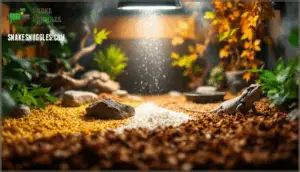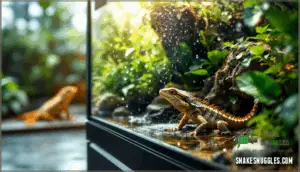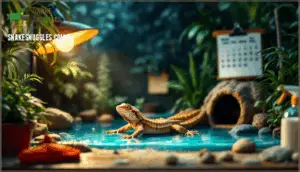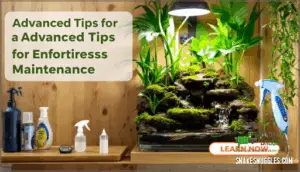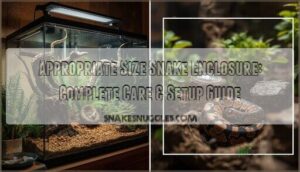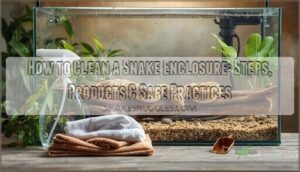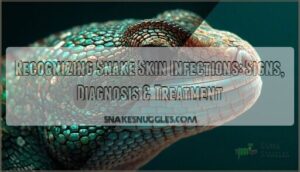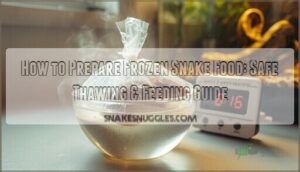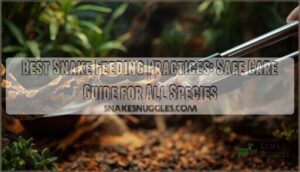This site is supported by our readers. We may earn a commission, at no cost to you, if you purchase through links.
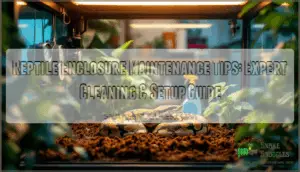
Proper reptile enclosure maintenance tips extend beyond wiping down glass; they encompass temperature mapping, substrate management, and creating cleaning protocols that won’t disrupt your animal’s stress-sensitive biology. With the right equipment and systematic approach, you can maintain ideal conditions while spending less time troubleshooting health crises.
This guide provides species-appropriate techniques that prevent common husbandry failures before they affect your reptile’s wellbeing.
Table Of Contents
Key Takeaways
- Most reptile health crises stem from mismatched cleaning schedules that ignore species-specific environmental needs—ball pythons require weekly cleaning to prevent respiratory infections, while maintenance frequency must align with your reptile’s humidity and temperature requirements rather than generic timelines.
- Temperature mapping with infrared guns and thermometer hygrometers prevents the majority of preventable health issues by maintaining precise thermal gradients (90-93°F warm zones, 70-75°F cool zones for leopard geckos) and proper UVB placement 12-18 inches above basking areas.
- Bioactive enclosures with beneficial microorganisms, isopods, and springtails reduce visible waste by over 80% within 24 hours and cut spot-cleaning frequency from daily to bi-weekly while stabilizing humidity within ±5% of ideal levels.
- Regular cleaning protocols directly reduce infections by 67%, parasitic infestations by 41%, and digestive disorders by 29%, making systematic maintenance your most cost-effective investment compared to veterinary interventions.
Essential Equipment for Safe Reptile Maintenance
Before you can properly maintain your reptile’s habitat, you need the right tools to keep both you and your animal safe. The equipment you choose makes cleaning more efficient while protecting your reptile from harm and preventing escapes during maintenance.
Let’s look at the essential gear every reptile keeper should have on hand.
Choosing Secure Exoterra Locks and Lids
Your reptile’s safety hinges on one often-overlooked detail: a lock that won’t budge when curious hands—or determined claws—test its limits. Exoterra locks and secure fasteners transform standard lid designs into escape prevention systems.
Consider these safety features:
- Lock mechanisms that click audibly—you’ll hear confirmation
- Dual-point secure fasteners for larger reptile enclosure setups
- Reinforced lid designs resistant to pushing from below
Proper enclosure maintenance starts with these foundational reptile care choices, protecting your animal while maintaining peace of mind.
Using Thermometer Hygrometers and Temperature Guns
Temperature monitoring isn’t guesswork—it’s the difference between a thriving reptile and one battling preventable health problems. Thermometer hygrometers track ambient conditions, while temperature guns reveal heat mapping across basking zones.
Proper sensor calibration guarantees accurate environmental tracking for effective thermoregulation. Together, these tools give you precise temperature and humidity control, helping you establish proper temperature gradients that support your reptile’s natural behaviors.
Selecting Nitrile Gloves and Safe Cleaning Supplies
Once you’ve nailed down the right environmental parameters, protecting yourself and your reptile during maintenance requires the right protective gear and cleaning products. Nitrile gloves prevent bacterial transfer between you and your pet.
For reptile enclosure cleaning, stick with reptile-safe cleaners like apple cider vinegar or Dawn dish soap—harsh chemicals damage sensitive respiratory systems. Store cleaning supplies separately from feeding tools, and always rinse surfaces thoroughly with Reptosafe-treated water.
Preparing Escape-Proof Backup Containers
Before you start any cleaning, you’ll need a temporary home that’s as secure as Fort Knox—because an escaped reptile mid-scrub isn’t just stressful, it’s dangerous for your pet.
Your backup container must match these critical specifications:
- Container size should accommodate your reptile comfortably without excessive space that allows climbing escapes
- Ventilation systems with small openings prevent suffocation while blocking escape attempts
- Secure latches on all access points—test them before transferring your reptile during reptile enclosure maintenance
- Emergency kits nearby containing your reptile safe cleaners for quick PVC reptile enclosure cleaning sessions
Setting Up an Optimal Reptile Enclosure
Setting up your reptile’s enclosure correctly from the start prevents most maintenance headaches down the road. A well-designed habitat keeps your pet healthy while making cleaning and monitoring much easier for you.
Let’s walk through the key decisions that will shape your enclosure’s foundation.
Choosing The Right Tank Size
Your reptile’s adult length determines its minimum enclosure needs. Research shows tank size guidelines directly impact reptile growth rates and behavior—undersized habitats stunt development and reduce activity. For species-specific needs, most adult snakes and lizards require enclosures at least 1.5 times their body length. A 4-foot tank works well for ball pythons and bearded dragons, while crested geckos need vertical space.
Enclosure volume effects extend beyond movement; proper space requirements support temperature and humidity control, creating a healthier reptile habitat that promotes natural behaviors essential for reptile care and maintenance throughout enclosure setup and design. Providing a suitable enclosure size guide is vital for the well-being of your pet.
Selecting Safe Substrates and Decor
Substrate choices impact your reptile’s health more than most keepers realize. Species-specific substrate requirements prevent impaction, maintain proper humidity, and support natural digging behaviors. You’ll want to evaluate these critical factors:
- Particle size matters—fine sand and loose substrates pose ingestion risks for many species
- Moisture retention varies between coconut fiber, cypress mulch, and reptile carpet
- Decor stability prevents injuries when climbing branches shift or topple
- Material compatibility with cleaning protocols vital reptilesafe materials withstand sanitization
Bioactive enclosures using substrate layers with live plants create self-cleaning systems, while reptile carpet offers simplicity for species prone to impaction. Match your habitat design to your animal’s natural environment and feeding behavior. Proper substrate maintenance is vital to prevent reptile health issues.
Creating Temperature Gradients and UVB Zones
Your reptile’s survival depends on precise temperature control and UVB lighting placement. Thermal gradients allow ectothermic animals to thermoregulate—leopard geckos need warm zones at 90–93°F and cool zones at 70–75°F. Position UVB bulbs 12–18 inches above basking zones to prevent metabolic bone disease.
Use infrared temperature guns and thermometer hygrometers to verify heat sources maintain stable gradients. Monitor these zones daily, as improper lighting and ventilation lead to respiratory infections and compromised immune function.
Ensuring Proper Humidity and Ventilation
Think of humidity as your reptile’s invisible lifeline—too little and respiratory passages dry out, too much and bacterial blooms take over. Use thermometer hygrometers to track humidity levels alongside temperature and humidity control systems.
Mist your reptile enclosure with treated water to maintain moisture management, but verify ventilation systems provide adequate air quality. Screen tops and adjustable vents prevent stagnant air while supporting climate regulation and proper ventilation.
Daily, Weekly, and Monthly Cleaning Schedules
A consistent cleaning routine keeps your reptile’s enclosure healthy and stress-free. Each cleaning level—daily, weekly, and monthly—fulfills a specific purpose in maintaining ideal conditions.
Here’s how to structure your maintenance schedule with the right techniques and tools for each stage.
Spot Cleaning Techniques and Tools
Every moment you delay removing waste from your reptile’s home increases their exposure to harmful bacteria, so mastering quick spot cleaning isn’t optional—it’s your frontline defense against disease. You’ll need the right tools to make daily spot cleaning efficient and stress-free for your pet.
Essential cleaning supplies include:
- Tweezers or long-handled tongs for precise waste removal without hand contact
- Nitrile gloves to prevent bacterial transfer during mess management
- Reptile-safe disinfectant spray for immediate surface sanitizing after removing feces
Keep these items near your reptile enclosure for swift action when you spot contamination.
Light Weekly Cleaning Steps
Once daily spot cleaning becomes routine, your weekly session takes things up a notch—this is where you catch the grime that sneaks past quick cleanups and keep your pet’s environment from crossing the line into hazardous territory.
Start by relocating your reptile to its escape-proof backup container. Wipe down glass surfaces, sanitize decorations with reptile-safe disinfectant, and assess substrate moisture for proper humidity control.
This weekly light cleaning removes accumulated waste while preventing the need for constant deep cleaning interventions.
Deep Monthly Sanitization Guide
While weekly maintenance catches surface issues, a monthly deep clean is your reset button—the only way to eliminate the bacteria, mineral deposits, and hidden buildup that threaten your reptile’s long-term health.
Remove all substrate, decor, and water dishes. Apply reptile-safe disinfectant to every surface, targeting biofilm removal with scrubbing motions. Use razor blades for stubborn mineral deposits on glass.
Rinse thoroughly with treated water before reassembling your reptile enclosure, guaranteeing complete enclosure sterilization.
Safe Use of Cleaning Solutions and Tools
Your cleaning arsenal needs a safety check before it touches your reptile’s home—some products labeled ‘safe’ can still off-gas fumes that damage delicate respiratory systems. Always choose reptile-safe disinfectant or eco-friendly cleaning products specifically formulated for animal enclosure cleaning.
Wear nitrile gloves during chemical management to prevent skin irritation. Let all surfaces air-dry completely after sanitization methods—residual moisture can trap harmful compounds.
Store cleaning supplies away from your reptile’s enclosure to prevent accidental exposure during deep cleaning sessions.
Preventing Health Issues Through Cleanliness
A clean enclosure isn’t just about aesthetics—it’s your reptile’s first line of defense against disease. When waste accumulates and humidity levels swing out of control, your pet faces real health risks that proper maintenance can prevent.
Let’s look at four key ways cleanliness directly protects your reptile’s well-being.
Reducing Odors and Respiratory Risks
Odor buildup in a reptile enclosure isn’t just unpleasant—it’s a red flag that harmful bacteria and ammonia are threatening your pet’s delicate respiratory system. Reptiles have highly sensitive airways, making consistent sanitation methods and humidity management essential for respiratory health.
Following a strict cleaning schedule improves air quality and odor control, protecting your reptile’s well-being whether you maintain traditional or bioactive enclosures.
Preventing Illness and Stress in Reptiles
Beyond clean air, thorough hygiene protocols and stress management protect reptile health at every level. Regular cleaning cuts infections by 67% and parasitic infestations by 41%, while daily waste removal lowers digestive disorders by 29%.
Proper environmental control—temperature gradients, humidity, and UVB zones—reduces behavioral stress incidents by 32% and assists natural thermoregulation.
When enclosure maintenance meets species-specific needs, disease prevention becomes straightforward and your reptile thrives.
Maintaining Environmental Stability
Consistency transforms a functional enclosure into a thriving microhabitat where temperature, humidity, and lighting remain predictably aligned with your reptile’s biological needs.
Daily monitoring with thermometer hygrometers prevents temperature gradients from collapsing, while checking humidity levels and UVB bulbs guarantees your reptile enclosure maintains stable air quality and proper water cycling.
Consistent lighting systems and adequate ventilation directly support temperature control and humidity management, keeping conditions exactly where your species requires them.
Promoting Natural Behaviors and Enrichment
A well-maintained enclosure doesn’t just prevent disease—it creates the spatial complexity and sensory cues that trigger basking, foraging, and exploratory behaviors essential to your reptile’s psychological well-being. Clean habitats allow for effective environmental enrichment and habitat diversity, giving your reptile the sensory experience it needs to thrive.
Enclosure maintenance directly fosters natural behaviors through:
- Behavioral stimulation from varied textures, hiding spots, and climbing structures
- Nutritional variety paired with clean feeding zones that encourage foraging instincts
- Reptile behavior and enrichment opportunities enabled by properly maintained temperature zones and basking areas
Advanced Tips for Effortless Enclosure Maintenance
Once you’ve mastered the basics, you can take your reptile care to the next level with some sophisticated strategies. These expert techniques reduce your workload while creating healthier, more stable environments for your animals.
Let’s explore how bioactive setups, smart technology, common pitfalls to avoid, and knowing when to call in expert help can transform your maintenance routine.
Bioactive Enclosures and Beneficial Microorganisms
Bioactive enclosures transform reptile enclosure maintenance by creating self-sustaining ecosystems. Beneficial microorganisms break down waste, while isopods and springtails reduce visible debris by over 80% within 24 hours.
These bioactive substrates support microbe balance and ecosystem stability, cutting spot-cleaning from daily to bi-weekly. Live plants stabilize microclimate control within ±5% of ideal humidity.
This progressive care approach bolsters reptile enrichment, promoting natural behaviors and reducing stress-related illness while maintaining substrate and decor selection that bolsters reptile health and wellness.
Integrating Automated Systems and Smart Sensors
Smart sensors and automated systems act like a digital safety net, catching temperature swings and humidity drops before they threaten your reptile’s health. These systems maintain precise temperature gradients and humidity levels while monitoring UVB bulbs for peak performance, reducing daily checks and giving you more time to focus on your reptile’s enrichment.
Tank automation streamlines climate control by adjusting automated lighting and ventilation in real-time.
Avoiding Common Cleaning Mistakes
Even experienced keepers can accidentally turn a routine cleaning session into a health hazard by using the wrong products or skipping essential safety steps. Household cleaners containing ammonia or bleach can damage your reptile’s respiratory system, so stick to reptile-safe disinfectants during your cleaning routine.
Don’t rush through deep clean procedures—incomplete sanitization methods leave harmful bacteria behind. Always follow proper hygiene protocols: remove your reptile to an escape-proof container, ventilate the enclosure thoroughly, and rinse surfaces completely before reintroducing your pet.
When to Seek Veterinary or Professional Help
Your reptile might be sending you distress signals long before you notice something’s wrong—and catching these warning signs early can make the difference between a quick fix and a serious health crisis.
Schedule professional veterinary care if you observe lethargy, breathing difficulties, abnormal feces, sudden appetite loss, or skin lesions. Reptile emergencies demand immediate professional advice—don’t attempt home treatments for serious health checks without consulting a veterinarian experienced in reptile health and animal welfare.
Frequently Asked Questions (FAQs)
How often should I replace UVB bulbs?
UVB bulbs seem permanent yet degrade invisibly—replace them every 6-12 months depending on manufacturer specifications. UVB intensity diminishes before visible light fades, compromising reptile vision and calcium metabolism.
Monitor lighting cycles with a solar meter to maintain proper UVB levels and temperature gradients essential for reptile care.
What are signs of improper humidity levels?
Humidity meters help you catch problems early. Watch for respiratory issues like wheezing, shedding problems with stuck skin, dehydration signs such as sunken eyes, and skin infections from excess moisture.
Proper humidity levels prevent these health complications.
How do I safely introduce new décor?
Think of new décor as a stranger entering your reptile’s territory—it needs proper introduction. Quarantine items for 24-48 hours, disinfect with reptile-safe cleaners, rinse thoroughly, and introduce gradually to minimize stress during habitat redesign while promoting visual enrichment through environmental enrichment.
Can I use tap water for misting?
Tap water can work for misting your reptile enclosure after proper treatment. Chlorine and chloramines pose tap water risks to reptile health, so use dechlorination methods like Reptosafe to neutralize these chemicals.
This ensures fresh water maintains ideal humidity and temperature levels.
What substrate depth is recommended for burrowing species?
Most fossorial species require substrate depths ranging from six to twelve inches to support natural digging behavior and tunnel stability. Sand-soil blends retain moisture for burrow integrity while accommodating species-specific needs.
Always research your reptile’s natural habitat for precise enclosure maintenance requirements.
Conclusion
The belief that weekly cleaning suffices for all species crumbles when you examine humidity-dependent pathogens in tropical setups versus arid environments. A ball python’s respiratory system won’t forgive substrate neglect, just as a bearded dragon won’t thrive in improperly sanitized spaces.
Your reptile’s longevity hinges on tailoring reptile enclosure maintenance tips to their biological requirements—not generic schedules borrowed from online forums. Master temperature mapping, establish species-specific protocols, and your enclosure becomes a health asset rather than a liability. Prevention through informed maintenance always costs less than veterinary intervention.
- https://www.zenhabitats.com/blogs/reptile-care-sheets-resources/how-to-clean-and-sanitize-your-bearded-dragon-s-habitat?srsltid=AfmBOooruFZpODmaLB3_3vWeEbX1Jn4mCBGNDzvmh59TofitWk2xeMzk
- https://www.tampavet.com/exotics-blog/cleaning-reptiles-habitat/
- https://www.oxyfresh.com/blogs/pet-health/snake-terrariums-101-your-guide-to-safe-cleaners
- https://www.thefbh.org/post/fbh-code-of-practice-for-recommended-minimum-enclosure-sizes-for-reptiles
- https://reptilenetworks.co.uk/2021/01/16/what-size-enclosure-for-my-bearded-dragon/


